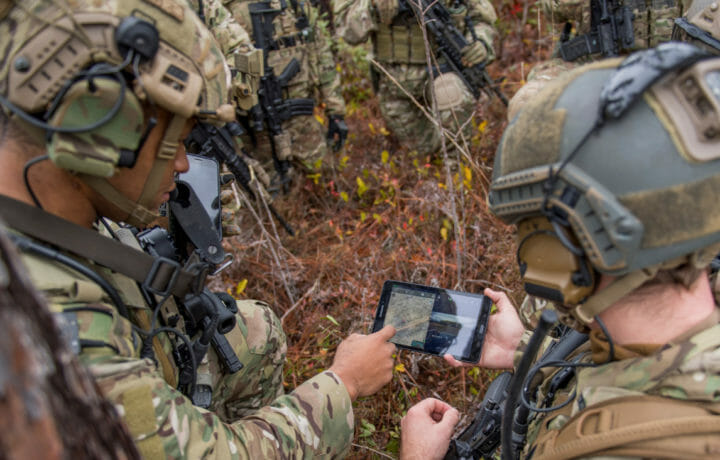On January 9, 1815 the United States Army under the command of future president Brevet Maj. Gen. Andrew Jackson defeated a significantly larger British Force in New Orleans in just over 30 minutes. Poor communications played a role in two significant ways.
First, along with poor planning, the lack of communications during the British assault resulted in significantly higher casualties. Second, and perhaps more importantly, the battle occurred 18 days after the signing of the Treaty of Ghent, which formally ended the war between the United States and Great Britain!
The ability for leaders to communicate with soldiers – even at extreme distances – has of course greatly improved in the past 207 years, but it could continue to play an even more significant role due to the increased adoption of the Internet of Military Things (IoMT).
Building on the Internet of Things
The term “Internet of Things” actually originated before most Americans had ever used or perhaps even heard of “the Internet.” In a speech to the Congressional Black Caucus Foundation 15th Annual Legislative Weekend in Washington, D.C. in September 1985, Peter T. Lewis – co-founder of the first U.S. cellular telephone company, Cellular One – told attendees, “The Internet of Things, or IoT, is the integration of people, processes and technology with connectable devices and sensors to enable remote monitoring, status, manipulation and evaluation of trends of such devices.”
Today, IoT is largely about making people live and work smarter – from smart home devices to self-driving cars to our fitness trackers. If the device can connect with another piece of hardware, it is part of the Internet of Things.
IoT has also become crucial to business as it can improve performance of machinery to help supply chain and logistics operations. It may not just be civilians at home or in the business world that benefit from IoT – it could have innumerable applications for the military.
The Internet of Military Things
Military innovations have largely trickled down to the civilian world – from radar to jet aircraft to the very Internet – but the Internet of Military Things (IoMT) is one where technology developed for civilian applications could in turn be militarized. It is still very much in an early stage of development, however its ability to speed up and increase the efficiency of the “observe, orient, decide, act” (OODA) loop could make it an invaluable tool in the hands of advanced militaries, suggested researchers at data and analytics company GlobalData.
The study noted that soldiers and decision-makers could now be thousands of miles away, but as modern warfare has become increasingly information-based, there needs to be a continual flow of up-to-date information to quickly provide the data to make the best decisions possible.
“Information always has been, and always will be, at the center of warfare and to maintain and increase competitive advantage in war, forces must understand and exploit the vast and constant streams of data collected on an array of connected things. The insights that can be derived from IoMT has the potential to transform warfare and serve as a force multiplier,” explained Dr. Lil Read, thematic analyst at GlobalData, via an email.
According to GlobalData’s new report, “Internet of Military Things – Thematic Research,” advanced military forces have invested in command, control, communications, computers, intelligence, surveillance, and reconnaissance (C4ISR) systems and infrastructure to collect, analyze, and disseminate data. This could result in the Internet of Battlefield Things (IoBT).
The individual elements of C4ISR could further provide situational awareness, communication and planning, while IoMT can be the tools and devices to bring all that information together into a single ecosystem. IoMT could employ multiple sensors deployed across various domains to acquire full situational awareness and control over diverse conflict zones and battle areas.
“There are multiple barriers and challenges to the widescale adoption of IoMT, even by advanced forces with large budgets,” added Read. “Tradeoffs in successful IoMT implementation will exist between interoperability, seamless information sharing, decision-making, and opening up the cybersecurity threat landscape.”
IoMT Challenges
The adoption of IoMT could very much resemble the civilian world’s IoT, which relies on technology to expand the capabilities of its network. It could therefore be open to some of the same threats as the IoT.
“This can include wearables, sensors, radar, munitions, vehicles, and robots. It can also include satellites and space station telemetry,” said Keenan Skelly, CEO of cybersecurity research firm Shadow Byte.
“While this enhances the speed and quality of data to the warfighter, creating rapid response capabilities and empowered on-the-ground forces, it is inherently a security risk like all other IoT,” Skelly told ClearanceJobs. “Expanding the attach surface for either will continue to plague widespread adoption. Take, for example, a vulnerability such as Log4j which is currently changing the way organizations have to view their networks and their apps across all devices. This wo’’t be the first time we see a global vulnerability of this scale and the next case may very well be the Internet of Military or Battlespace things.”




